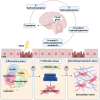The potential therapeutic role of melatonin in organ fibrosis: a comprehensive review
- PMID: 39735699
- PMCID: PMC11681627
- DOI: 10.3389/fmed.2024.1502368
The potential therapeutic role of melatonin in organ fibrosis: a comprehensive review
Abstract
Organ fibrosis is a pathological process characterized by the inability of normal tissue cells to regenerate sufficiently to meet the dynamic repair demands of chronic injury, resulting in excessive extracellular matrix deposition and ultimately leading to organ dysfunction. Despite the increasing depth of research in the field of organ fibrosis and a more comprehensive understanding of its pathogenesis, effective treatments for fibrosis-related diseases are still lacking. Melatonin, a neuroendocrine hormone synthesized by the pineal gland, plays a crucial role in regulating biological rhythms, sleep, and antioxidant defenses. Recent studies have shown that melatonin may have potential in inhibiting organ fibrosis, possibly due to its functions in anti-oxidative stress, anti-inflammation, remodeling the extracellular matrix (ECM), inhibiting epithelial-mesenchymal transition (EMT), and regulating apoptosis, thereby alleviating fibrosis. This review aims to explore the therapeutic potential of melatonin in fibrosis-related human diseases using findings from various in vivo and in vitro studies. These discoveries should provide important insights for the further development of new drugs to treat fibrosis.
Keywords: fibrosis; mechanisms; melatonin; protective effects; therapeutics.
Copyright © 2024 Huang, Zheng, Wang, Du, Bai and Tang.
Conflict of interest statement
The authors declare that the research was conducted in the absence of any commercial or financial relationships that could be construed as a potential conflict of interest.
Figures


Similar articles
-
Therapeutic potential of melatonin in targeting molecular pathways of organ fibrosis.Pharmacol Rep. 2024 Feb;76(1):25-50. doi: 10.1007/s43440-023-00554-5. Epub 2023 Nov 23. Pharmacol Rep. 2024. PMID: 37995089 Review.
-
Melatonin prevents LPS-induced epithelial-mesenchymal transition in human alveolar epithelial cells via the GSK-3β/Nrf2 pathway.Biomed Pharmacother. 2020 Dec;132:110827. doi: 10.1016/j.biopha.2020.110827. Epub 2020 Oct 13. Biomed Pharmacother. 2020. PMID: 33065391
-
Granzyme B in Inflammatory Diseases: Apoptosis, Inflammation, Extracellular Matrix Remodeling, Epithelial-to-Mesenchymal Transition and Fibrosis.Front Immunol. 2020 Nov 11;11:587581. doi: 10.3389/fimmu.2020.587581. eCollection 2020. Front Immunol. 2020. PMID: 33262766 Free PMC article. Review.
-
Beneficial effects of melatonin on liver fibrosis: A systematic review of current biological evidence.J Cell Physiol. 2022 Jul;237(7):2740-2757. doi: 10.1002/jcp.30735. Epub 2022 Apr 11. J Cell Physiol. 2022. PMID: 35404472 Free PMC article.
-
Melatonin: the dawning of a treatment for fibrosis?J Pineal Res. 2016 Mar;60(2):121-31. doi: 10.1111/jpi.12302. Epub 2016 Jan 17. J Pineal Res. 2016. PMID: 26680689 Review.
Cited by
-
Protective Effect of Melatonin Against Bisphenol A Toxicity.Int J Mol Sci. 2025 Aug 4;26(15):7526. doi: 10.3390/ijms26157526. Int J Mol Sci. 2025. PMID: 40806654 Free PMC article. Review.
References
-
- Lerner AB, Case JD, Takahashi Y, Lee TH, Mori W. Isolation of melatonin, the pineal gland factor that lightens MELANOCYTES1. J Am Chem Soc. (1958) 80:2587–7. doi: 10.1021/ja01543a060 - DOI
Publication types
LinkOut - more resources
Full Text Sources

